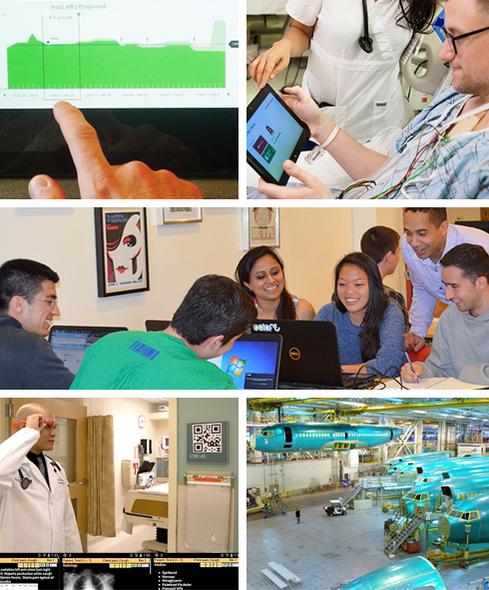Internet Of Things Demands Open StandardsInternet Of Things Demands Open Standards
IoT will shift the focus from technology to ideas -- if we get integration right. Heterogeneous System Architecture is a step in that direction.


20 Great Ideas To Steal In 2014
20 Great Ideas To Steal In 2014 (Click image for larger view and slideshow.)
Next-generation computing and Internet networking -- a combination I call "connected computing" -- promises great potential as we move toward an Internet of Things-enabled future. But first, we must vastly improve interoperability and communications protocols, common processing and programming interfaces, and tools to dissolve the barriers between diverse computing platforms, devices, and operating systems.
If this effort fails, the Internet of Things will be seriously hampered at best. At worst, it will be little more than the Internet of Babel.
The Internet of Things describes a vast array of Internet-connected devices, appliances, sensors, and objects, and their virtual representations -- "things" that are managed, inventoried, and monitored wirelessly. ABI Research estimates there will be more than 30 billion wirelessly connected devices by the end of the decade. By 2020 -- a mere six years from now -- Gartner Group predicts the aggregated value and economic benefit of IoT will exceed $19 trillion.
Here's the problem: Today's Internet is overwhelmingly composed of computers and devices that are completely dependent on data captured and created by humans. People write documents, build databases, photograph and upload images. But the year 2020 will see almost the exact opposite, according to technologist Kevin Ashton (who coined the term "The Internet of Things"), as hundreds of millions of Internet-connected devices primarily use information that originates from other devices. Broadly speaking, this is also known as machine-to-machine (M2M) communications, a fast-growing portion of the embedded systems market.
{image 2}
Ashton says the next-generation IoT has the potential to change the world, and I agree. By eliminating human beings as the primary creators and "routers" of information, the IoT becomes an ultra-efficient auto-organizing entity that handles all the myriad mundane details -- liberating human beings to focus on ideas.
For this to happen, however, communication must take place on multiple levels, from the hardware that comprises the physical underpinnings of the IoT -- the internal computing parts inside each device -- to the communications protocols and methodologies that links from device to device and from the device to the cloud and back.
The good news: This is already happening, especially on the hardware front. A new open computing system architecture called Heterogeneous System Architecture (HSA), with matching programming tools, is emerging as the next-generation industry standard that integrates different types of microprocessors and compute elements.
[You can keep only three security products -- which ones stay? Tell us here: InformationWeek's 2014 Strategic Security Survey. Enter to win a 64 GB iPad or a consultation with report author Michael A. Davis.]
This heterogeneous design combines graphics and compute engines to produce faster performance and better visual displays with much lower energy consumption. It does this by blending the serial-processing operations of conventional computer CPUs with the parallel-processing capabilities of graphics processing units (GPUs), and optimizing digital signal processors (DSPs) and other performance accelerators via high-bandwidth shared memory access. The result is much greater efficiency as the different compute elements work together seamlessly.
The Heterogeneous System Architecture Foundation is a consortium of computer industry leaders, including AMD, ARM, Imagination Technologies, LG Electronics, Mediatek, Oracle, Qualcomm, Samsung, Texas Instruments, and more than 40 additional companies, along with a variety of academic institutions, including Northeastern University. It's dedicated to creating this more efficient approach to computer architecture. In addition to its obvious performance benefits, another key attribute of the architecture is broad portability across computing devices. Applications written using HSA tools will be easy to move across compliant platforms, enabling a write-once, run-nearly-anywhere opportunity. This will greatly boost compatibility for many applications within the Internet of Things.
HSA features are prominent in the latest accelerated processing unit (APU) microprocessor designs. Using HSA to unify different types of processing cores, including CPUs and GPUs within a single silicon chip, AMD has -- for the first time in the industry -- enabled synchronized operation of both processor types using heterogeneous queuing (hQ), and holistically sharing random-access memory and data using heterogeneous uniform memory access (hUMA). By incorporating HSA, these APUs are the most advanced computing platform on the market, pioneering a new path for the technology industry.
Heterogeneous platforms are now emerging in every domain of computing, from high-performance computers and servers to power-sipping tablets, mobile phones, and embedded devices. Boosting processing efficiencies and enabling new processing capabilities, these processors step boldly into the next era of computer system architecture and innovation. They represent a fundamental step toward connecting the 30 billion IoT devices by 2020.
Our InformationWeek Elite 100 issue -- our 26th ranking of technology innovators -- shines a spotlight on businesses that are succeeding because of their digital strategies. We take a close at look at the top five companies in this year's ranking and the eight winners of our Business Innovation awards, and offer 20 great ideas that you can use in your company. We also provide a ranked list of our Elite 100 innovators. Read our InformationWeek Elite 100 issue today.
About the Author
You May Also Like






